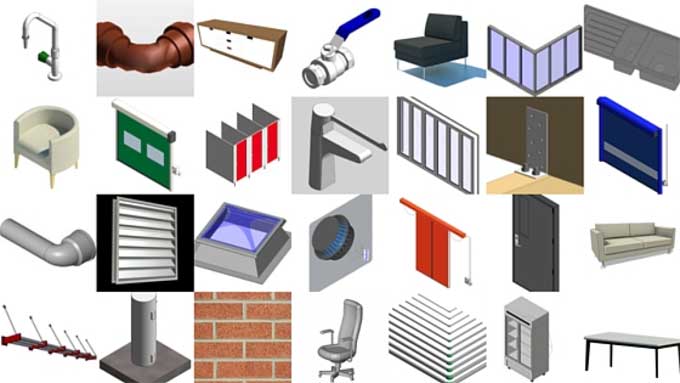Revit families: Different types
Tweet
Families are essentially a collection of objects with a shared set of characteristics known as Parameters and the corresponding graphical representation. It is essential to utilizing the Software that we understand how everything in the Revit platform relates to a family.
Every element we employ, including Walls, Columns, Mechanical Equipment, and Annotation Tags, belongs to the Revit family, which has a clear hierarchy. The hierarchy's highest level are the Revit Categories, which cannot be added to, changed, or eliminated.
There are two main families of Revit Categories:-
1. Texts, tags, and dimensions are among the components that make up an annotation category.
2. All elements contained inside the building model, such as doors, windows, floors, and walls, fall under the model categories.
Revit family types
A general classification of Revit families can be made as follows:-
Families related to System
The System Families are the fundamental components that come together on a building site. They are pre-defined components in the Revit platform, and the Revit User Interface cannot be used to add or remove them.
The specifications for these kinds of families are already pre-defined, so you don't even need to import them into your projects or save them somewhere else. However, inside a System Family, we can replicate and change the "Types."
'Types' are merely groups of variables that may be added, changed, or removed according to the user's requirements. The reason for this is that most system families are made up of many types in order to be customized to meet the needs of individual projects.
Families related to Component
Standard component families, commonly referred to as loadable families, contain parts that are typically bought, transported, and installed in buildings.
Families that may be loaded include, for instance, doors, windows, furniture, water heaters, and plumbing fixtures. According to the needs of the project, these user-defined families may be established and adjusted in Revit.
The Loadable Families, in contrast to System Families, may be stored as external RFA files and imported into projects as needed.
As a consequence, models are produced more quickly and with greater accuracy. Architects may immediately import the components that are currently accessible in the active project.
Families related to specific project requirements
The In-Place families are specialized parts that are typically developed in response to particular project requirements. In terms of creation and modification methods, they are comparable to component or loadable families because both make use of the same Revit Family editor.
In-Place Families cannot be used to produce several "Types" or be saved as external RFA files since they are project-specific and cannot do either.
Within the framework of the project, Family Editor makes it simple to develop individualized and flexible items. It is incredibly helpful for buildings with intricate and unusual design circumstances.
It is usually preferable to employ in-place families whenever appropriate even if we can replicate, move, or copy them between projects because these elements can increase file size and impair program performance.
Families of annotations
Annotation families play an essential role in organizing drawings and other kinds of documents. There are two families that contain it: System and Loadable.
Others, like Generic Model Tags or Symbols, may be imported into other projects and can be saved as external RFA files. Some family kinds, such Dimension Style, Levels, etc., cannot be generated or altered. It does not need complicated characteristics compared to other family kinds.
Families of hosted
Family models with hosted elements are those that have a host element that can pick up the model elements and provide structure and support for them as necessary.
Families of components, or families that can be loaded from a catalog, can be hosted on system families, for example lighting fixtures can be hosted on ceilings.
Imported 3D geometry Revit Families
A proficient user of Revit may develop accurate and realistic libraries as well as import libraries and 3D geometry from other programs that support the relevant file types. More reliable and high-quality 3D models may be obtained by importing 3D geometry.
To get online demonstration, watch the following video tutorial.
Video Source: Balkan Architect
Families based on parametric data
There are several differences between a family and a static object in the simplest of terms, but what makes a family powerful is that it is capable of changing its size, shape or properties based on the inputs of the user.
The most common method of accomplishing this is to add the necessary parameters and dimensions to an existing Revit family.
Download Free Revit Families
Wrapping it up
Revit Platform's building blocks are families. A customized loadable family's high operational flexibility and reusability make it a popular choice for Architects, Interior Designers, and Contractors.

Gallery
Feel free to contact us for BIM requirements. One of our representative will respond you within 24 Hours. Send us your projects requirement today and grow your project.
Explore More !







